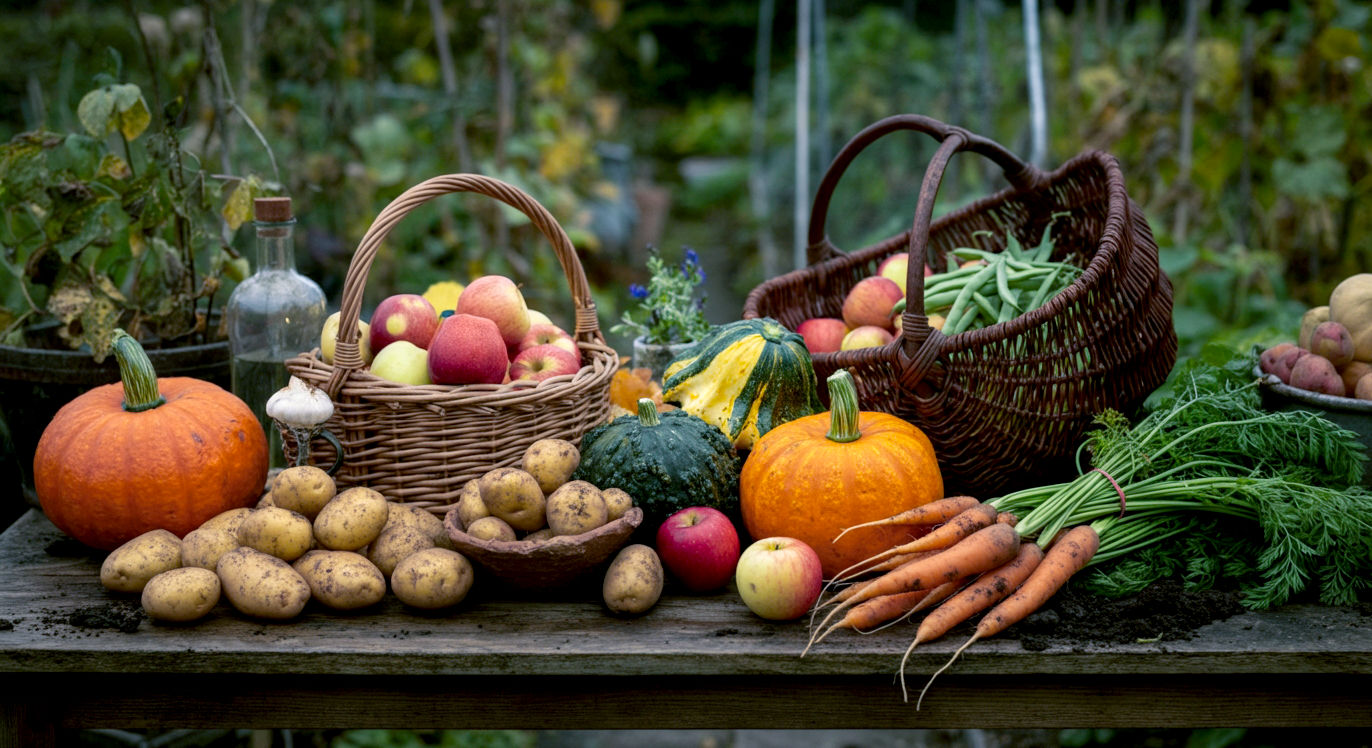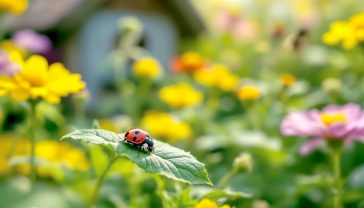Harvest Horizons: The Guide to Timing Your Harvests for Seasonal Success
The guide to timing your harvest. Discover the secrets to picking vegetables and fruit at the perfect moment for maximum flavour and yield.

This post may contain affiliate links. If you make a purchase through these links, we may earn a commission at no additional cost to you.
There’s a moment in every gardener’s year that’s pure magic. It’s not the sowing of a tiny seed or the first brave sprout pushing through the soil. It’s the taste of the first sun-warmed tomato, picked straight from the vine, its sweetness bursting in your mouth. It’s the satisfying thud of a perfect cabbage, solid and heavy in your hands. This is the payoff, the delicious reward for months of digging, watering, and hoping.
But here’s a little secret that seasoned growers know: knowing how to grow is only half the battle. Knowing precisely when to harvest is the other half, and it’s the real key to unlocking the most incredible flavour, the best nutrition, and a pantry that stays stocked long after the growing season has faded.
Picking a courgette a day too late can mean the difference between a tender, nutty delight and a watery, oversized marrow. Lifting your potatoes a week too early could cost you a significant portion of your crop. It’s a game of timing, observation, and understanding what your plants are trying to tell you.
This guide is your new best friend in that game. Forget vague instructions on seed packets. We’re going to walk you through the sights, sounds, smells, and feelings of a perfectly timed harvest, season by season, right here in the unpredictable British weather. Whether you have a sprawling allotment, a few pots on a patio, or a classic back garden veg patch, you’ll learn how to read the signs and reap the rewards like never before. Let’s get our hands dirty.
The Gardener’s Sixth Sense: Learning the Universal Signs of Ripeness
Before we dive into a seasonal calendar, you need to learn the language of your plants. Ripeness isn’t just a date; it’s a conversation. Your vegetables and fruits will give you plenty of clues when they’re ready. You just need to tune in your senses.
Look: The Clue is in the Colour
This is the most obvious sign, but it has its nuances. We’re trained to look for the deep, uniform red of a tomato or the rich orange of a pumpkin. For the most part, this works beautifully. A strawberry should be ruby-red all over, with no white or green tip. A blackcurrant should be a deep, glossy black, not a dull purple.
But don’t be fooled. Some varieties are meant to be different colours, like yellow ‘Golden Boy’ tomatoes or purple ‘Dragon’s Tongue’ French beans. And sometimes, we harvest before the final colour change. For a classic British chutney, you’ll want firm, green tomatoes. The key is to know what you planted and what its final, perfect form looks like.
Touch: A Question of Firmness and Feel
Touch is your secret weapon. Gently squeeze your crops (gently!) to learn what’s going on inside.
- Solid and Heavy: A ripe cabbage, lettuce, or cauliflower should feel dense and solid for its size. If it feels light and airy, the heart hasn’t formed properly.
- A Little Give: This is the classic test for fruits like pears, peaches, and avocados. They shouldn’t be rock hard or mushy. A ripe pear will yield to gentle pressure near the stem.
- The Snap Test: Beans and peas are all about the snap. A French bean or runner bean should break cleanly and crisply. If it bends or feels leathery, it’s past its best and will be stringy. A pea pod should feel plump and full, not wrinkly.
Size: When Bigger Isn’t Always Better
This is the number one mistake for new gardeners. We see something growing huge and think we’ve hit the jackpot. More often than not, you’ve missed the moment of peak flavour.
- Courgettes: The eternal example. They are at their most delicious when they’re about 10-15cm (4-6 inches) long. Leave them another day, and they start turning into watery, seedy marrows that are best suited for the local village fair’s ‘biggest vegetable’ competition.
- Beetroot & Turnips: Harvest these at about the size of a cricket ball. Much larger and they can become woody and lose their sweetness.
- Cucumbers: These should be firm and a consistent dark green. If they start to bulge in the middle or turn yellow, they’re overripe, and the seeds will be bitter.
Sound & Smell: The Forgotten Indicators
Don’t be afraid to get up close and personal with your produce.
- Smell: The fragrance of a ripe fruit is unmistakable. A row of strawberries will perfume the air on a warm day. Herbs are at their most pungent and aromatic right before they start to flower. A ripe melon will smell sweet at the end where it was attached to the vine.
- Sound: This one is mostly for the melon family. Give a melon or a winter squash a good tap. You want to hear a dull, hollow thud. A high-pitched, ringing sound means it’s not ready yet.
A Year in Your Veg Patch: A Seasonal Harvesting Calendar for the UK
Armed with your new sensory skills, let’s map out the gardening year. Remember, this is a guide. A cold, wet spring in the Scottish Highlands will mean everything is a few weeks behind a sunny season in Cornwall. Always let your plants have the final say.
Spring’s First Treasures: Harvesting from March to May
After a long winter, these first harvests feel like a miracle. They are fresh, vibrant, and a welcome break from winter stodge, helping to bridge the dreaded ‘hungry gap’.
Leafy Greens & Stems
- Rhubarb: Don’t even think about harvesting in its first year—let it get established. From the second year, you can start picking. Look for firm, crisp stalks that are at least 30cm (12 inches) long. Don’t cut them; grasp the stalk near the base and pull with a gentle twisting motion. It should come away cleanly. Always leave at least half the stalks on the plant to power next year’s growth. And remember, the leaves are poisonous, so they go straight on the compost heap.
- Spring Cabbage: These are the pointed ‘hispi’ or ‘greyhound’ types. You’re looking for a firm, well-packed heart. Give it a gentle squeeze. When it feels dense, use a sharp knife to cut the head at the base, just above the soil level.
- Spinach & Chard: You can harvest these in two ways. Either cut the whole plant at the base or, for a much longer harvest, use the ‘cut-and-come-again’ method. Simply pick the outer leaves, leaving the smaller, central ones to grow on. The plant will keep producing new leaves for weeks.
- Lettuce: As with spinach, you can either wait for a full heart to form on ‘romaine’ or ‘iceberg’ types, or you can pick the outer leaves from ‘loose-leaf’ varieties as soon as they are big enough for a sandwich.
Early Roots & Shoots
- Radishes: These are the sprinters of the veg patch. They can be ready in as little as four weeks. Start checking them once you see the top of the root peeking out of the soil. You want them to be about 2.5cm (1 inch) across. Any bigger and they can become woody and fiery.
- Spring Onions: Harvest these whenever they are big enough to use. Just gently pull them from the soil. You can start when they are pencil-thin and let others grow fatter.
- Asparagus: This is the king of spring vegetables and requires patience. Don’t cut any spears in the first two years. In the third year, you can have a modest harvest for a few weeks. Look for spears that are about 15-20cm (6-8 inches) tall and the thickness of your finger. Use a sharp knife to cut them just below the soil surface. Stop harvesting by mid-June to let the plant grow its beautiful ferns, which will feed the crown for next year’s crop.
Summer’s Bounty: Harvesting from June to August
This is peak season. The allotment is buzzing, the sun is (mostly) out, and everything is growing at a frantic pace. Regular picking is essential now; it tells the plants to keep producing more.
The Salad Bowl Heroes
- Tomatoes: The ultimate sign of summer. Wait for a deep, even colour (unless it’s a variety that ripens green or yellow). It should feel firm but not hard and will pull away from the vine with a gentle tug. For the very best flavour, pick them in the afternoon when the sun has warmed them and concentrated their sugars.
- Cucumbers: Pick these when they are a uniform size and colour. Don’t let them get too fat or turn yellow. Regular picking is the key to a good crop. If you leave a big one on the vine, the plant will think its job is done and stop producing new flowers.
- Peppers & Chillies: You can pick these green, but the flavour will be much sweeter and richer (and in the case of chillies, hotter) if you let them ripen to their final colour of red, yellow, or orange. Cut them from the plant with secateurs, leaving a small piece of stem attached.
Pods and Legumes
- Peas: The best way to know if peas are ready is to feel the pod. It should be plump and feel full of round peas. If you can’t really feel the individual peas, they need more time. If the pod is wrinkly or dull, you’ve left them too long. Pick from the bottom of the plant upwards, as these pods ripen first.
- Broad Beans: Harvest these when the beans are visible through the pod. For the sweetest, most tender beans, pick them young when the ‘scar’ (where the bean was attached to the pod) is still white or green. If the scar is black, the beans will be tougher and better suited for stews.
- French & Runner Beans: This is a daily job in high summer. Pick them young and tender, before the bean inside starts to swell and the pod becomes tough. For runners, they should snap cleanly. If they bend, they’re too old. The more you pick, the more they’ll produce.
Roots and Alliums
- First Early/New Potatoes: Timing is linked to flowering. About two weeks after the plants have finished flowering, you can start to ‘furtle’ around in the soil with your hands. Gently scrape away some soil at the base of a plant and see what you find. You’re looking for potatoes about the size of a hen’s egg. Lift only what you need for the next few days, as they don’t store well.
- Garlic & Onions: These are ready when the leaves start to yellow and flop over. This is a sign that the plant has stopped sending energy to the leaves and is putting it all into the bulb. Choose a dry day, gently lift them with a fork, and leave them on the soil surface to dry in the sun for a few days. This starts the curing process, which is essential for long-term storage.
Soft Fruits
- Strawberries, Raspberries, etc.: Pick these on a dry morning when they are cool but not damp with dew. They bruise easily, so handle them with care. Pick strawberries with the green calyx (the leafy cap) still attached, as this helps them last longer. With raspberries, a ripe fruit will come away from its central plug with a gentle pull. If you have to tug, it’s not ready.
Autumn’s Golden Haul: Harvesting from September to November
The air is getting cooler, but the allotment is still giving generously. This is the time for the big, satisfying crops that will see you through the winter.
The Maincrop Harvest
- Maincrop Potatoes: Unlike new potatoes, these are your keepers. Wait until the foliage has completely yellowed and died back, usually in late September. Cut the foliage off at the base and leave the potatoes in the ground for another two weeks. This helps their skins to ‘set’ or toughen up, which makes them store much better. Choose a dry, sunny day to lift them with a fork, being careful not to spear them.
- Carrots & Beetroot: You can lift these as you need them, but for storage, get them all out of the ground before the first hard frost. Use a fork to loosen the soil and pull them up. Twist off the foliage straight away; if you leave it on, it will continue to draw moisture and nutrients from the root, making it shrivel.
- Parsnips: The absolute opposite of carrots. Parsnips need a good frost to taste their best. The cold temperature encourages the plant to convert its starches into sugars, making the roots wonderfully sweet and nutty. You can leave them in the ground all winter and lift them as needed.
The Brassica Brigade
- Cabbages & Cauliflowers: As with their spring cousins, you’re looking for a firm, dense head. A cauliflower should be a clean, white colour with tightly packed florets. You can bend one of its own leaves over the head a week or so before harvesting to protect it from the sun, a technique called ‘blanching’.
- Broccoli & Calabrese: Harvest the main central head when the florets are dark green and tightly packed, before the tiny yellow flowers start to open. Cut it with a good length of stem. Don’t pull up the plant! It will reward you by producing lots of smaller side-shoots for a bonus harvest.
- Brussels Sprouts: Another vegetable that improves after a frost. They ripen from the bottom of the stalk upwards. Start picking the lowest sprouts when they are firm, tightly closed, and about the size of a large marble or a walnut. Snap them off with a sharp downward tug.
Winter Squashes and Pumpkins
- These need to be harvested before the first hard frost. A sure sign of ripeness is the colour – it should be deep and uniform. But the most important test is the skin. Try to pierce it with your thumbnail. If you can’t, it’s ready. The skin needs to be hard to protect the flesh inside during storage. Cut them from the vine with a few inches of stem attached (don’t use the stem as a handle, it might break off!).
Orchard Fruits
- Apples & Pears: Don’t just pull them. Use the ‘cup and twist’ method. Cup the fruit in your palm, lift it slightly, and give it a gentle quarter-turn. If it’s ripe, the stem will break away easily. If it resists, give it a few more days.
- Plums: A ripe plum will feel soft but not squishy and will often have a dusty white ‘bloom’ on its skin. They should come away from the tree with a light pull.
Winter’s Hardy Survivors: Harvesting from December to February
Your plot might look bare, but there are still delicious things to be had. These are the tough guys of the vegetable world, standing strong against the frost and snow.
The Winter Warriors
- Leeks: You can harvest these all winter long. Use a fork to loosen the soil around their base and gently pull. They are incredibly hardy and can be left in the ground until you’re ready to put them in a stew.
- Kale & Perpetual Spinach: Like parsnips and sprouts, the flavour of kale is often improved by a frost. Keep picking the outer leaves using the cut-and-come-again method.
- Winter Cabbages: The big, crinkly-leaved ‘Savoy’ types are the stars of the winter garden. Harvest them as you would any other cabbage, looking for a solid, heavy heart.
Late Roots
- Parsnips & Swedes: As mentioned, these can be your winter store cupboard, right there in the soil. Just go out and dig them up as needed.
Tools for the Task: Getting Kitted Out for Harvest
You don’t need a lot of fancy gear, but the right tool makes the job quicker, cleaner, and better for your plants.
- A Sharp Knife or Secateurs: Essential for cutting cabbages, broccoli, and peppers cleanly without damaging the plant.
- A Garden Fork: The best tool for lifting root vegetables like potatoes and carrots with minimal damage.
- A Trug or Bucket: The classic Sussex Trug is a beautiful and practical choice for carrying your harvest without bruising it.
- Cleanliness is Key: Always use clean tools. Wiping your knife blade between plants can help prevent the spread of diseases.
Beyond the Harvest: Smart Techniques for a Longer Season
A well-timed harvest isn’t just about single crops; it’s about planning your plot to give you food for as long as possible.
The ‘Cut-and-Come-Again’ Philosophy
We’ve mentioned this a few times, and it’s a game-changer. For leafy crops like lettuce, spinach, chard, and kale, harvesting the outer leaves regularly tricks the plant. It thinks, “I haven’t made any seeds yet, I’d better grow more leaves!” This can extend your harvest from a single plant for months.
Succession Sowing: The Secret to a Continuous Supply
Instead of sowing a whole packet of lettuce seeds in April, sow a short row every two weeks. This avoids a ‘glut’ where you have 20 lettuces all ready at once, followed by none for the rest of the summer. A little bit of planning means you’ll have a steady, manageable supply right through the season.
Harvesting for Storage vs. the Plate
The perfect moment for eating isn’t always the perfect moment for storing. Onions are a great example. You can pull them young and green to chop into a salad. But for an onion you want to be using next February, you must wait for the tops to yellow and fall over, then lift and cure it properly by drying it in the sun or a greenhouse until the outer skins are papery. The same goes for winter squash, which needs to be cured to harden its skin for long-term storage.
The Great British Weather and Your Harvest
Ah, the weather. The national obsession and the gardener’s constant challenge. A cool, damp summer can bring on blight in tomatoes and potatoes, forcing an early harvest to save what you can. An early autumn frost can mean a frantic rush to get your squashes and beans under cover. You have to be adaptable. Keep an eye on the forecast and be prepared to act.
Frost isn’t always the enemy, though. As we’ve seen, it’s a magical ingredient for sweetening parsnips, sprouts, and kale. Understanding this relationship with our climate is what makes British gardening so unique and rewarding.
Storing Your Bounty: Making the Harvest Last
The final piece of the puzzle is knowing how to store your perfectly-timed harvest.
- Cool, Dark, and Dry: This is the mantra for most storage crops. A garage, a shed, or a cool pantry is ideal. Store potatoes in hessian or paper sacks (never plastic, they’ll sweat and rot). Braid onions and garlic into traditional strings and hang them up.
- In the Ground: The easiest storage method of all! Leeks, parsnips, and swedes can happily sit in the soil until you need them.
- Freezing, Drying, and Preserving: Gluts are inevitable. Learn the basics of preservation. Runner beans and peas freeze brilliantly. Herbs can be dried and stored in jars. A glut of tomatoes or plums can be turned into delicious chutneys and jams that will bring a taste of summer to the darkest winter day.
Conclusion: The End of the Harvest is Just the Beginning
Harvesting is so much more than just picking vegetables. It’s the culmination of a season’s work and a deep connection to the food you eat. By learning to read the subtle cues of your plants, you elevate your gardening from a simple hobby to a rewarding skill. You learn to work with the seasons, to anticipate the needs of your crops, and to appreciate the incredible flavour of food harvested at its absolute peak.
The satisfaction of pulling a perfect carrot from the soil or filling a trug with your own apples is immense. It’s a rhythm that connects us to generations of growers before us. And as the last of the autumn harvest is safely stored away, the cycle begins again. It’s time to pour over the seed catalogues, plan next year’s patch, and dream of that first, magical, sun-warmed tomato of summer.
Further Reading:






